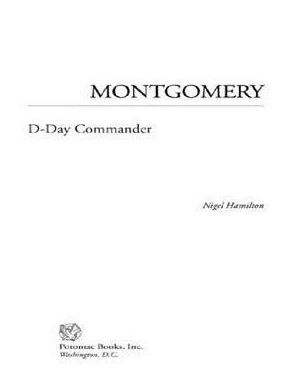Montgomery: D-Day Commander
This fascinating study of military leadership follows British general Bernard Law Montgomery's military career from his cadet days and service in World War I to his great victories of World War II, including his defeat of the great German panzer commander, Erwin Rommel, at Alamein.
Nigel Hamilton presents a brilliant, arrogant Montgomery, who refused to bow to authority and skated on the edge of dismissal like his American counterpart, George S. Patton. Though very different in their command styles, Montgomery and Patton became the two most successful Allied field generals in World War II. From North Africa through the invasion of Sicily, they routed the Germans in battle, with Patton as a thrusting cavalryman and Montgomery as an infantry commander devoted to applying massive force at a vital point. The author contends that Montgomery's planning and leadership transformed Operation Overlord from a Second Front project doomed to fail into a successful Allied invasion plan.
Allied operations after Normandy foundered in bitter arguments and failure, for Montgomery at Arnhem and Patton at Metz. Had Montgomery and Patton been ordered to fight in the same direction after Normandy, argues Professor Hamilton, the Allies might have ended the war in Europe in 1944. As it was, Montgomery and Patton had to save the Allies from sensational defeat in the Battle of the Bulge in what was to be their last battle together. The war ended for Monty on May 4, 1945, when he accepted the surrender of all German forces in the north.
1111666831
Nigel Hamilton presents a brilliant, arrogant Montgomery, who refused to bow to authority and skated on the edge of dismissal like his American counterpart, George S. Patton. Though very different in their command styles, Montgomery and Patton became the two most successful Allied field generals in World War II. From North Africa through the invasion of Sicily, they routed the Germans in battle, with Patton as a thrusting cavalryman and Montgomery as an infantry commander devoted to applying massive force at a vital point. The author contends that Montgomery's planning and leadership transformed Operation Overlord from a Second Front project doomed to fail into a successful Allied invasion plan.
Allied operations after Normandy foundered in bitter arguments and failure, for Montgomery at Arnhem and Patton at Metz. Had Montgomery and Patton been ordered to fight in the same direction after Normandy, argues Professor Hamilton, the Allies might have ended the war in Europe in 1944. As it was, Montgomery and Patton had to save the Allies from sensational defeat in the Battle of the Bulge in what was to be their last battle together. The war ended for Monty on May 4, 1945, when he accepted the surrender of all German forces in the north.
Montgomery: D-Day Commander
This fascinating study of military leadership follows British general Bernard Law Montgomery's military career from his cadet days and service in World War I to his great victories of World War II, including his defeat of the great German panzer commander, Erwin Rommel, at Alamein.
Nigel Hamilton presents a brilliant, arrogant Montgomery, who refused to bow to authority and skated on the edge of dismissal like his American counterpart, George S. Patton. Though very different in their command styles, Montgomery and Patton became the two most successful Allied field generals in World War II. From North Africa through the invasion of Sicily, they routed the Germans in battle, with Patton as a thrusting cavalryman and Montgomery as an infantry commander devoted to applying massive force at a vital point. The author contends that Montgomery's planning and leadership transformed Operation Overlord from a Second Front project doomed to fail into a successful Allied invasion plan.
Allied operations after Normandy foundered in bitter arguments and failure, for Montgomery at Arnhem and Patton at Metz. Had Montgomery and Patton been ordered to fight in the same direction after Normandy, argues Professor Hamilton, the Allies might have ended the war in Europe in 1944. As it was, Montgomery and Patton had to save the Allies from sensational defeat in the Battle of the Bulge in what was to be their last battle together. The war ended for Monty on May 4, 1945, when he accepted the surrender of all German forces in the north.
Nigel Hamilton presents a brilliant, arrogant Montgomery, who refused to bow to authority and skated on the edge of dismissal like his American counterpart, George S. Patton. Though very different in their command styles, Montgomery and Patton became the two most successful Allied field generals in World War II. From North Africa through the invasion of Sicily, they routed the Germans in battle, with Patton as a thrusting cavalryman and Montgomery as an infantry commander devoted to applying massive force at a vital point. The author contends that Montgomery's planning and leadership transformed Operation Overlord from a Second Front project doomed to fail into a successful Allied invasion plan.
Allied operations after Normandy foundered in bitter arguments and failure, for Montgomery at Arnhem and Patton at Metz. Had Montgomery and Patton been ordered to fight in the same direction after Normandy, argues Professor Hamilton, the Allies might have ended the war in Europe in 1944. As it was, Montgomery and Patton had to save the Allies from sensational defeat in the Battle of the Bulge in what was to be their last battle together. The war ended for Monty on May 4, 1945, when he accepted the surrender of all German forces in the north.
9.95
In Stock
5
1

Montgomery: D-Day Commander

Montgomery: D-Day Commander
9.95
In Stock

Product Details
| ISBN-13: | 9781612340661 |
|---|---|
| Publisher: | Potomac Books Inc. |
| Publication date: | 04/30/2007 |
| Sold by: | Barnes & Noble |
| Format: | eBook |
| File size: | 2 MB |
About the Author
From the B&N Reads Blog
